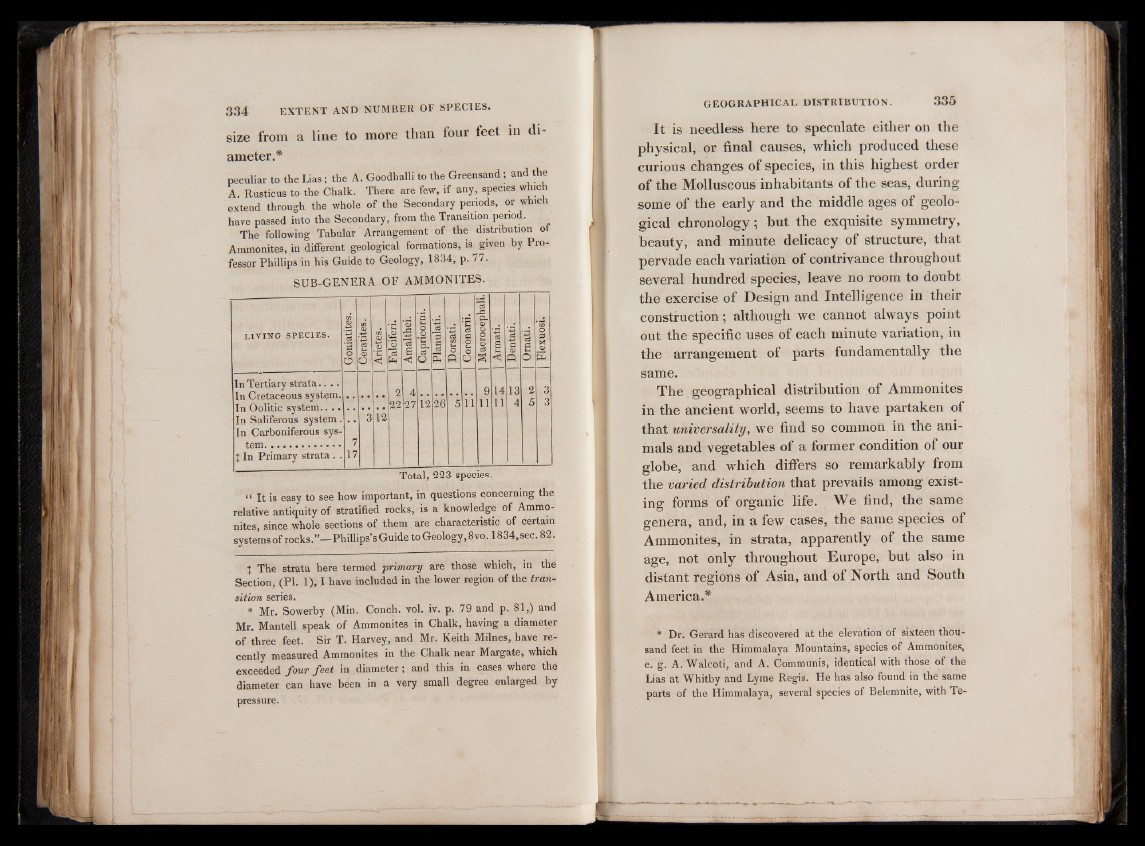
size from a line to more than four feet in diameter.*
*
peculiar to the Lias ; the A. Goodhalli to the Greensand ; and the
A. Rusticus to the Chalk. There are few, if any, species which
extend through the whole of the Secondary periods, or which
have passed into the Secondary, from the Transition period.
The following Tabular Arrangement of the distribution of
Ammonites, in different geological formations, is given by Professor
Phillips in his Guide to Geology, 1834, p. 77.
SUB-GENERA OF AMMONITES.
LIVING SPECIES.
1 Goniatites.
1 Ceratites. |
1 Arietes.
1 Falciferi. |
1 Amalthei.
1 Capricorn!. |
1 Planulati.
1 Dorsati.
1 Coronarii.
1 Macrocephali.
j Armati.
1 Dentati.
1 Ornati.*o3j 1 3X <u
s
In Tertiary strata. . . .
In Cietaceous system. 2 4 9 14 13 2 3
22 27 12 26 5 11 11 11 4 5 3
In Saliferous system.
In Carboniferous sys-
7
3 12
J In Primary strata . . 17
Total, 223 species.
“ It is easy to see how important, in questions concerning the
relative antiquity of stratified rocks, is a knowledge of Ammonites,
since whole sections of them are characteristic of certain
systems of rocks.”— Phillips’s Guide to Geology, 8vo. 1834, sec. 82.
j The strata here termed primary are those which, in the
Section, (PI. 1), I have included in the lower region of the transition
series.
* Mr. Sowerby (Min. Conch, vol. iv. p. 79 and p. 81,) and
Mr. Mantell speak of Ammonites in Chalk, having a diameter
of three feet. Sir T. Harvey, and Mr. Keith Milnes, have recently
measured Ammonites in the Chalk near Margate, which
exceeded four fe e t in diameter ; and this in cases where the
diameter can have been in a very small degree enlarged by
pressure.
GEOGRAPHICAL DISTRIBUTION. 335
It is needless here to speculate either on the
physical, or final causes, which produced these
curious changes of species, in this highest order
of the Molluscous inhabitants of the seas, during
some of the early and the middle ages of geological
chronology; but the exquisite symmetry,
beauty, and minute delicacy of structure, that
pervade each variation of contrivance throughout
several hundred species, leave no room to doubt
the exercise of Design and Intelligence in their
construction; although we cannot always point
out the specific uses of each minute variation, in
the arrangement of parts fundamentally the
same.
The geographical distribution of Ammonites
in the ancient world, seems to have partaken of
that universality, we find so common in the animals
and vegetables of a former condition of our
globe, and which differs so remarkably from
the varied distribution that prevails among existing
forms of organic life. We find, the same
genera, and, in a few cases, the same species of
Ammonites, in strata, apparently of the same
age, not only throughout Europe, but also in
distant regions of Asia, and of North and South
America.*
* Dr. Gerard has discovered at the elevation of sixteen thousand
feet in the Himmalaya Mountains, species of Ammonites,
e. g. A. Walcoti, and A. Communis, identical with those of the
Lias at Whitby and Lyme Regis. He has also found in the same
parts of the Himmalaya, several species of Belemnite, with Te